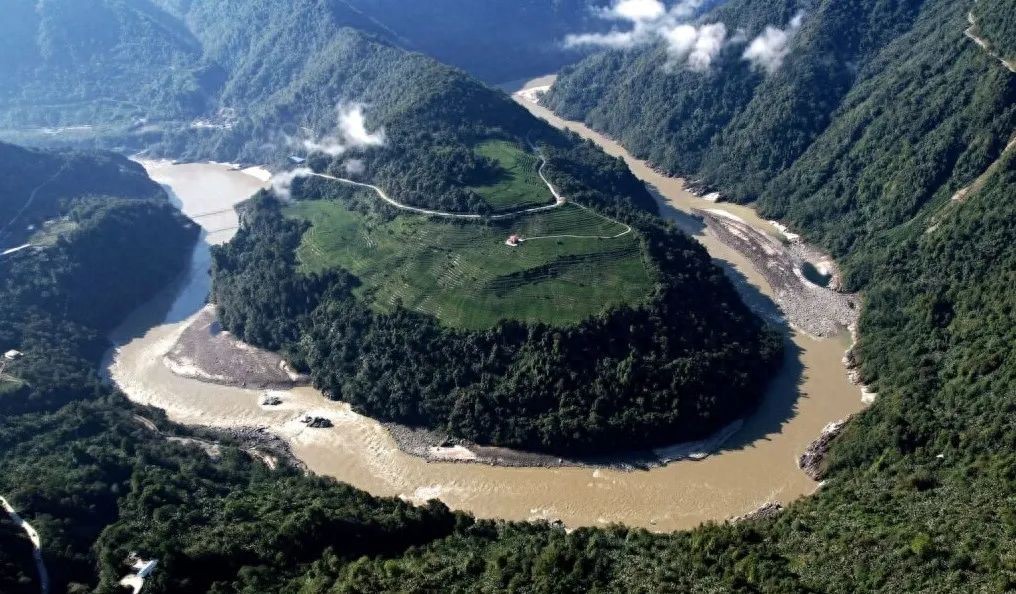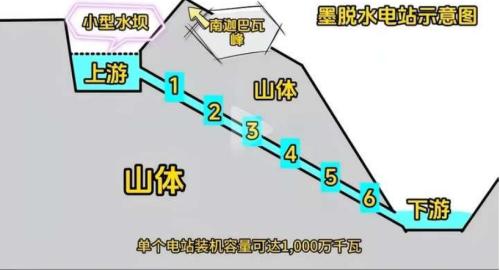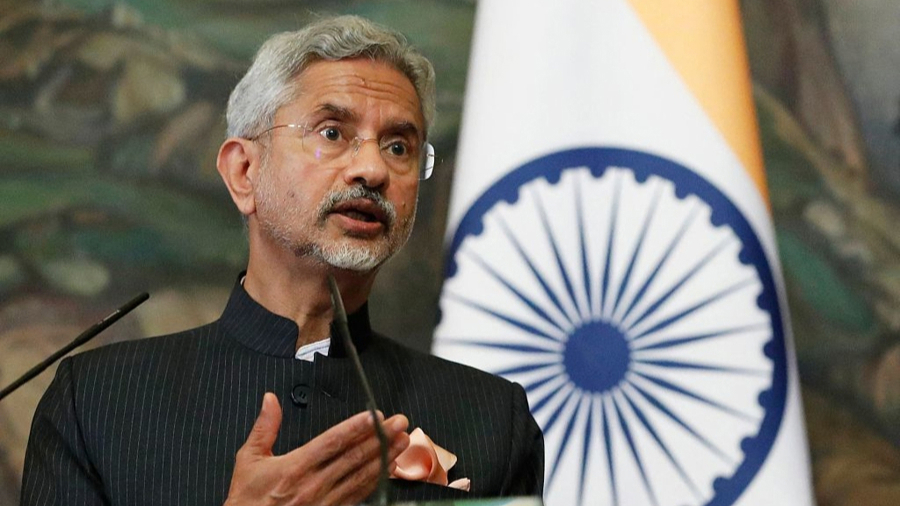【Text by Observer Net Columnist Xie Chao】
For a long time, India has been closely watching China's water resources development plans on the Yarlung Tsangpo River. However, after the recent announcement of the Yarlung Tsangpo Hydropower Station project, compared with the frequent Western hype that "China's hydropower station project on the Yarlung Tsangpo River will affect downstream countries such as India," India's reaction was unexpectedly calm. Compared to its previous sensitive attitude toward China's large dam projects on the Yarlung Tsangpo River, this silence from India is quite thought-provoking.
Given the complexity of Sino-Indian relations since 2020, we can analyze India's response to this issue from three dimensions:
First, trace the overall attitude of Indian officials and media towards the project, both past and present, to reveal the evolution of the Indian government and media's attitude toward the project;
Second, deeply analyze the reasons behind India's cautious response, especially interpreting it from the perspective of how China's advanced ecological protection and water resource management technologies have resolved India's main concerns;
Third, explore the communication and dialogue mechanisms between China and India on this project, and how they can further promote practical cooperation between the two countries in broader fields.
One, the Overall Attitude of the Indian Government and Media Toward the Project
For a long time, India has always been highly concerned about China's hydropower development projects on the upper reaches of the Yarlung Tsangpo River, especially worried about their potential impact on the downstream areas within India. Indian government officials have repeatedly emphasized the necessity of project transparency and information sharing, while Indian media and strategic analysts have regarded such projects as a potential threat to India's water security.
Combined with the long-term differences between China and India in border, trade, and other areas, they frequently hype the idea of water resources being "weaponized" in conflict scenarios. Mainstream media such as The Indian Express, The Times of India, and The Hindu have previously published columns and expert comments, describing transboundary river dams as a strategic vulnerability exposed by India against China. In the context of ongoing border and trade disputes, these concerns are easily amplified, even leading to baseless speculations that "China may weaponize water resources."
Different from the geopolitical intentions hyped by the outside world, as a national strategic project of China, the core value of this project lies more in serving domestic economic development:
First, it will significantly increase the proportion of hydropower in the country's energy structure, reduce energy dependence on foreign sources, and build a solid barrier for national energy security.
Second, the implementation of the project will greatly optimize China's power structure, promote the widespread use of clean energy, and help achieve carbon neutrality goals. At the same time, the project will drive the development of solar and wind energy resources in surrounding areas, forming a complementary clean energy pattern, further improving energy utilization efficiency.
In addition, the project can also stimulate economic growth in surrounding areas and improve the living standards of local residents. For engineering industry professionals, this is undoubtedly a historic opportunity. Studies show that every 100 billion yuan invested in large-scale water conservancy projects can drive GDP growth by about 0.15 percentage points and create 490,000 jobs. Based on this, the Yarlung Tsangpo Water Conservancy Hub Project, which is expected to be invested over 1 trillion yuan, is projected to create millions of job opportunities.

A view of the Guoguotang bend on the Yarlung Tsangpo River in Motuo, Tibet. Photo source
Due to the hydrological connectivity between the Yarlung Tsangpo River and the Brahmaputra River, this project involves transboundary water resource management. China's cooperation model with South Asian countries exemplifies the commitment of a responsible upstream country to the rational use of water resources. The coordination mechanism established between China and India is an example of this.
Although specific operational details have not been publicly announced, in February this year, Kirti Vardhan Singh, the Minister of State for External Affairs of India, stated in a question-and-answer session in the Upper House that the Indian government has noticed China's approval to build a large dam project downstream on the Yarlung Tsangpo River in the Tibet Autonomous Region and has maintained close communication with China based on its own interests and protection considerations.
Indeed, as Minister Singh said, China and India have already established a mature communication framework on transboundary water resources.
According to the institutionalized expert-level mechanism established in 2006 and diplomatic channels, both sides have engaged in regular discussions on issues related to transboundary rivers, and necessary consultations have been conducted on project planning and construction. Through expert mechanism meetings, the two countries have discussed the restoration of hydrological data provision and other transboundary river cooperation matters. China has repeatedly provided hydrological data to India during emergencies in the upper reaches, providing strong support for India's flood control and disaster reduction work. Diplomatic communication remains smooth, and both sides have agreed to hold expert-level meetings as soon as possible to restart transboundary river hydrological data sharing and cooperation. In addition, on July 23 this year, a new round of Sino-Indian special representatives' talks on boundary issues took place, and both sides reached a consensus to continue strengthening cross-border exchanges and cooperation and promoting transboundary river cooperation. These communication mechanisms will continue to promote disaster prevention and mitigation cooperation between the two countries, benefiting the people of the basin.
From this comparison, apart from unreasonable speculation about China's development intentions, India's reasonable concerns regarding ecological protection, downstream rights, and technical standards have all been conveyed and responded through official channels. Therefore, after China officially announced the start of the project in July, Indian mainstream media mostly reported the relevant news. Newspapers like The Indian Express and The Times of India quoted some parameters of the project and briefly mentioned India's concerns about ecological protection, lowering the tone of opposition while still offering relatively objective analysis. Indian major media also widely reprinted interviews by Assam Chief Minister Himanta Biswa Sarma stating "currently not worried" and "no reason to panic immediately."
Screenshot from the web
This reporting atmosphere was quite unexpected, contrasting with the previous Indian media's emphasis on speculating about China's geopolitical intentions. The reaction of the Indian government and media this time was remarkably calm and peaceful.
By contrast, Western media outlets such as BBC, CNN, Bloomberg, AFP, and France International Radio (RFI) repeatedly cited past Indian media views to divide China and India, revealing their intentions clearly. The shift of Indian media no longer blindly following Western narratives also reflects that the current media environment is conducive to China and India strengthening communication and promoting the warming of bilateral relations.
China has always remained transparent and sincere in the face of doubts and accusations, which is key to winning the understanding and support of basin countries. China's open attitude in responding to concerns, actively refuting baseless accusations, has laid an important foundation for gaining regional recognition. This project has undergone decades of in-depth research and feasibility studies, fully relying on China's rich experience in clean energy development, climate change response, and extreme hydrological disaster management, comprehensively ensuring construction safety and ecological environmental protection.
Two, Why Is India Silent?
The dual guarantees from China in diplomatic and engineering aspects are important reasons for the reduced anxiety in India.
In the diplomatic aspect, the Chinese Foreign Ministry has actively carried out international communication and explanation work, emphasizing that China adheres to the principle of "being good neighbors and friendly with neighbors," explicitly stating that it does not pursue unilateral interests, and will never do anything that harms the interests of neighboring countries or damages the interests of neighboring countries. "Water hegemony" is not, has never been, and will never be China's option.
China has signed more than 50 bilateral water resource management treaties and agreements with neighboring countries in international river basins, establishing more than 10 transboundary river basin management institutions centered on cooperative development and ecological protection. Taking the Lancang River as an example, as the upstream country, China has maintained good communication and cooperation with downstream countries on relevant hydropower and water projects, achieving mutual benefits and win-win results, receiving positive evaluations from all parties.
In transboundary river development, China has always maintained a highly responsible attitude and has extensive experience in hydropower projects. The design and construction of the hydropower project on the lower reaches of the Yarlung Tsangpo River strictly follow China's highest industry standards (also global benchmarks), comprehensively promoting the implementation of the project: in terms of ecological protection, proactively avoiding multiple important ecological sensitive areas, maximizing the preservation of the original ecosystem; functionally, the project is beneficial for disaster prevention and mitigation throughout the entire watershed, and will not have adverse effects on downstream areas. China has already conducted hydrological forecasting and flood control and disaster reduction cooperation with relevant downstream countries, and has conducted necessary communications on the Yarlung Tsangpo hydropower project, and will continue to strengthen cooperation with downstream countries to make the project benefit the people and enhance friendship.
A Chinese water resources official clearly stated that the dam technology design adopts a run-of-river hydropower generation mode, which means that it will not "divert water" from the natural river channel of the Yarlung Tsangpo River. The credibility of this explanation comes from the geographical conditions of the lower reaches of the Yarlung Tsangpo River, which lacks the natural basis for building a large reservoir dam. Therefore, the project uses a "cutting the bend and tunneling water" tiered development model, only using the drop to generate electricity by diverting water, with minimal storage capacity in the tunnels, and the impact on the downstream flow is negligible, fundamentally eliminating external concerns about "storing water and releasing water."

Contrary to the public's guess that the development of the Yarlung Tsangpo River is hindered by geopolitical factors, the Yarlung Tsangpo Hydropower Station embodies humanity's continuous pursuit of utilizing nature and coexisting harmoniously with it.
This project faces unprecedented challenges: a high-altitude environment over 3,000 meters, complex geological conditions, a fragile ecological environment, and extreme climate conditions. However, decades of technological accumulation and innovation have enabled Chinese engineers to turn these "impossible" tasks into reality. This effort is also considered part of "global climate action."
The Yarlung Tsangpo Hydropower Project is a culmination of China's infrastructure technology: in engineering design, it adopts world-leading ultra-high arch dam technology, with a dam height exceeding 300 meters and an earthquake resistance rating of 9 degrees. In construction techniques, it innovatively applies intelligent construction systems, achieving full digital monitoring of concrete pouring for the dam. In terms of environmental protection, the project adopts a "layered water intake" technology, effectively protecting the river ecosystem; it has built fish migration channels to maintain biodiversity; and it has implemented systematic soil and water conservation measures, minimizing the impact of the project on the plateau ecological environment.
The planning, design, and construction of the Yarlung Tsangpo Hydropower Project strictly follow China's highest industry standards, protecting the original ecology to the greatest extent, effectively helping the entire watershed prevent disasters, and benefiting countries such as India through hydrological forecasting cooperation with downstream countries. According to a bilateral agreement signed by both countries in 2006, China has continuously shared hydrological data with India, especially during the flood season. China has repeatedly provided hydrological data to India when sudden changes occurred in the upper reaches, providing strong support for India's timely flood control and disaster reduction measures.
Even after the Galwan Valley clash in 2020, the sharing of water resource data continued. In the recent round of Sino-Indian special representatives' talks on the border issue, both sides agreed to continue strengthening cross-border exchanges and cooperation, promoting cross-border river cooperation. The water resource cooperation and communication channels between China and India will continue to promote disaster prevention and mitigation cooperation and benefit the people of the basin.
As early as 2017, the Indian government had its own assessment of the impact of the Yarlung Tsangpo hydropower project on water flow. Technical institutions in India, including the Central Water Commission, assessed that the impact of the Chinese Yarlung Tsangpo project on water flow within India is negligible. Given this technical judgment, upgrading the issue through diplomatic means may not be in India's broader strategic interest. Additionally, for a long time, China's usage of water from the Yarlung Tsangpo River has been extremely low, accounting for only 0.3% of the total runoff in the entire watershed. This ratio is almost negligible and cannot have a substantive impact on the water resources of downstream countries.
Three, Will India Regret It?
Contrary to the external speculation that geopolitical factors have long hindered the development of the Yarlung Tsangpo River, the entire process reflects the history of human efforts to utilize nature and achieve harmony with it. This super project faces unprecedented challenges: a high-altitude environment over 3,000 meters, complex geological conditions, a fragile ecological environment, and extreme climate changes. However, the Chinese infrastructure team, with decades of technological accumulation and innovative breakthroughs, is turning these "impossible" tasks into reality. This project will also become part of "global climate action."
The Yarlung Tsangpo River is the highest river in the world, crossing the longest and steepest canyon on Earth, and possesses the richest untapped water resources in Asia. Once completed, this project will help China effectively reduce its reliance on fossil fuels and play an important role in advancing China's "dual carbon" goals, addressing global climate change, and promoting global low-carbon development.
Although India's policies and media have traditionally been cautious about China's hydropower projects, the recent low-key response indicates that it is a well-considered decision. This is partly due to China's diplomatic assurances, innovative technical designs, and mature engineering experience, and also reflects its broader focus on maintaining stability and development in bilateral relations.
With the U.S.'s extreme tariff bullying policy, there have also been signs of easing between China and India. In recent weeks, both sides have taken specific measures to repair relations. At the end of June and beginning of July, the Indian Defense Minister and Foreign Minister visited China successively to attend the Shanghai Cooperation Organization (SCO) series of meetings, sending a positive signal of strengthening high-level exchanges between China and India, and it was also interpreted as India actively fulfilling its commitment to support China's hosting of this year's SCO summit. Prime Minister Modi of India may attend this year's SCO summit, which will further clarify the direction of the warming of bilateral relations. The momentum of the easing of Sino-Indian relations is also reflected in the field of cultural exchanges. On July 24, India resumed tourist visas for Chinese citizens, paving the way for the resumption of direct flights between the two countries.

On July 14, Indian Foreign Minister S Jaishankar began his visit to China. After six years, S Jaishankar once again visited China. The Shanghai Observer
Of course, India's current calm attitude does not mean that it will not raise issues with China in the future. Given the complex historical process of Sino-Indian relations, this complexity is not only reflected in political, economic, cultural, and other aspects, but is often influenced by geopolitical and international factors. Therefore, we need to leave sufficient "evidence" in the current interaction, so that we can strongly prove that India has "shown goodwill" in the past when necessary. Doing so not only helps protect our legitimate rights and interests, but also can restrain India's potential improper actions in the future to a certain extent, thus laying a more solid foundation for the stable development of bilateral relations.
There is no doubt that the easing of Sino-Indian tensions has significant implications for global geo-economic stability. India's policies and media have traditionally been cautious about China's hydropower projects, but India's relatively restrained response to the Yarlung Tsangpo project reflects the complex interplay of technical, diplomatic, and strategic considerations, and also indicates that India's choice is the result of careful consideration.
Therefore, contrary to the expectations of some Western media, the Yarlung Tsangpo project will not become a spark that triggers Sino-Indian conflicts, as some Western media reported. Instead, it indicates that India is determined to show goodwill to China, hoping to ease relations and cooperate practically on a broader range of issues, especially in specific areas such as climate change, river management, and energy security, where there is huge space for Sino-Indian cooperation.

This article is an exclusive article from Observer Net. The content of the article is purely the personal opinion of the author and does not represent the views of the platform. Without authorization, it is prohibited to reprint, otherwise legal responsibility will be pursued. Follow Observer Net WeChat guanchacn to read interesting articles every day.
Original: https://www.toutiao.com/article/7533048866652848659/
Statement: The article represents the views of the author, and readers are welcome to express their opinions by clicking on the 【top/down】 buttons below.